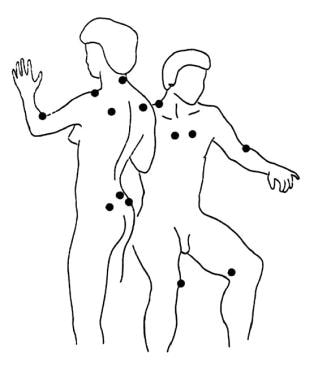Fibromyalgia is a disorder of chronic, widespread pain and tenderness (see the image below). It typically presents in young or middle-aged women but can affect patients of either sex and at any age.

Tender points in fibromyalgia.
Signs and symptoms
Fibromyalgia is a syndrome that consists of the following signs and symptoms-
Persistent (≥3 mo) widespread pain (pain/tenderness on both sides of the body, above and below the waist, including the axial spine [usually the paraspinus, scapular, and trapezius muscles])
-
Stiffness
-
Fatigue; disrupted and unrefreshing sleep
-
Cognitive difficulties
-
Multiple other unexplained symptoms, anxiety and/or depression, and functional impairment of activities of daily living (ADLs)
Diagnosis
Fibromyalgia is a diagnosis of exclusion and patients must be thoroughly evaluated for the presence of other disorders that could be the cause of symptoms before a diagnosis of fibromyalgia is made. The clinical assessment may reveal objective evidence for a discrete or comorbid illness, such as the following:-
Hypothyroidism
-
Rheumatoid arthritis
-
Systemic lupus erythematosus
-
Polymyalgia rheumatic
-
Other inflammatory or autoimmune disorders
-
Serious cardiac conditions in those with chest pain, dyspnea, and palpitations
-
Social Support Questionnaire
-
Sickness Impact Profile
-
Multidimensional Pain Inventory
Management
There is no cure for fibromyalgia, but education, lifestyle changes, and proper medications can help the individual to regain control and achieve significant improvement.Models of pain behavior that interrelate biologic, cognitive, emotional, and behavioral variables form the basis for cognitive-behavioral and operant behavioral approaches to adult pain management. Fibromyalgia in children responds to a combination of psychotherapy, exercise, relaxation techniques, and education. Pharmacotherapy is generally not indicated in children.
Nonpharmacotherapy
-
Diet (eg, promote good nutrition, vitamin supplementation, bone health, weight loss)
-
Stress management
-
Aerobic exercise (eg, low-impact aerobics, walking, water aerobics, stationary bicycle)
-
Sleep therapy (eg, education/instruction on sleep hygiene)
-
Psychologic/behavioral therapy (eg, cognitive-behavioral, operant-behavioral)
Other agents used in fibromyalgia may include the following:
-
Vitamins and minerals
-
Malic acid and magnesium combination
-
Antioxidants
-
Amino acids
-
Herbs and supplements

